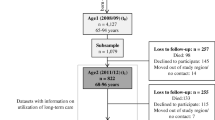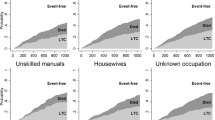Abstract
Background
The need for long-term care services increases with age. However, little is known about the predictors of long-term care (LTC) entry among the oldest old.
Aims
Aim of this study was to assess predictors of LTC entry in a sample of men and women aged 90 years and older.
Methods
This study was based on the Vitality 90 + Study, a population-based study of nonagenarians in the city of Tampere, Finland. Baseline information about health, functioning and living conditions were collected by mailed questionnaires. Information about LTC was drawn from care registers during the follow-up period extending up to 11 years. Cox regression models were used for the analyses, taking into account the competing risk of mortality.
Results
During the mean follow-up period of 2.3 years, 844 (43%) subjects entered first time into LTC. Female gender (HR 1.39, 95% CI 1.14–1.69), having at least two chronic conditions (HR 1.24, 95% CI 1.07–1.44), living alone (HR 1.37, 95% CI 1.15–1.63) and help received sometimes (HR 1.23, 95% CI 1.02–1.49) or daily (HR 1.68, 95% CI 1.38–2.04) were independent predictors of LTC entry.
Conclusion
Risk of entering into LTC was increased among women, subjects with at least two chronic conditions, those living alone and with higher level of received help. Since number of nonagenarians will increase and the need of care thereby, it is essential to understand predictors of LTC entry to offer appropriate care for the oldest old in future.
Similar content being viewed by others
References
Statistics Finland (2017) Population according to age and gender 1970–2016. http://pxnet2.stat.fi/PXWeb/pxweb/en/StatFin/StatFin__vrm__vaerak/?tablelist=true. Accessed 2017
Statistics Finland (2017) Population projection 2015 according to age and sex 2015–2065. http://pxnet2.stat.fi/PXWeb/pxweb/en/StatFin/StatFin__vrm/?rxid=3446fcc3-2523-4a81-9843-57e5cd9139dd. Accessed 2017
STAKES (2007) Care and services for older people 2005. National Research and Development Centre for Welfare and Health, Helsinki
Forma L, Aaltonen M, Pulkki J et al (2017) Long-term care is increasingly concentrated in the last years of life: a change from 2000 to 2011. Eur J Public Health 27:665–669
Sotkanet (2017) Statistics and Indicator Bank; National Institute for Health and Welfare 2005–2017. https://www.sotkanet.fi/sotkanet/en/index. Accessed 2017
Gnjidic D, Stanaway FF, Cumming R et al (2012) Mild cognitive impairment predicts institutionalization among older men: a population-based cohort study. PLoS One 7:e46061
Luppa M, Luck T, Weyerer S et al (2010) Prediction of institutionalization in the elderly. A systematic review. Age Ageing 39:31–38
Bharucha AJ, Pandav R, Shen C et al (2004) Predictors of nursing facility admission: a 12-year epidemiological study in the United States. J Am Geriatr Soc 52:434–439
Martikainen P, Moustgaard H, Murphy M et al (2009) Gender, living arrangements, and social circumstances as determinants of entry into and exit from long-term institutional care at older ages: a 6-year follow-up study of older Finns. Gerontologist 49:34–45
Grundy E, Jitlal M (2007) Socio-demographic variations in moves to institutional care 1991–2001: a record linkage study from england and wales. Age Ageing 36:424–430
Woo J, Ho SC, Yu AL et al (2000) An estimate of long-term care needs and identification of risk factors for institutionalization among Hong Kong Chinese aged 70 years and over. J Gerontol A Biol Sci Med Sci 55:M64–M69
von Bonsdorff M, Rantanen T, Laukkanen P et al (2006) Mobility limitations and cognitive deficits as predictors of institutionalization among community-dwelling older people. Gerontology 52:359–365
Nuotio M, Tammela TL, Luukkaala T et al (2003) Predictors of institutionalization in an older population during a 13-year period: the effect of urge incontinence. J Gerontol A Biol Sci Med Sci 58:756–762
Gaugler JE, Duval S, Anderson KA et al (2007) Predicting nursing home admission in the U.S: a meta-analysis. BMC Geriatr 7:13
Aguero-Torres H, von Strauss E, Viitanen M et al (2001) Institutionalization in the elderly: the role of chronic diseases and dementia. Cross-sectional and longitudinal data from a population-based study. J Clin Epidemiol 54:795–801
Castora-Binkley M, Meng H, Hyer K (2014) Predictors of long-term nursing home placement under competing risk: evidence from the health and retirement study. J Am Geriatr Soc 62:913–918
Murphy TE, Han L, Allore HG et al (2011) Treatment of death in the analysis of longitudinal studies of gerontological outcomes. J Gerontol A Biol Sci Med Sci 66:109–114
Jylhä M, Hervonen A (1999) Functional status and need of help among people aged 90 or over: a mailed survey with a total home-dwelling population. Scand J Public Health 27:106–111
Jylhä M, Enroth L, Luukkaala T (2013) Trends of functioning and health in nonagenarians: the vitality 90+ study. In: Robine J, Jagger C, Crimmins E (eds) Annual review of gerontology and geriatrics. Springer Publishing Company, pp 313–332
Statistics Finland (2017) Population structure 2016. http://www.stat.fi/tup/suoluk/suoluk_vaesto_en.html. Accessed 2017
Sund R (2012) Quality of the Finnish hospital discharge register: a systematic review. Scand J Public Health 40:505–515
Martikainen P, Moustgaard H, Einio E et al (2014) Life expectancy in long-term institutional care by marital status: multistate life table estimates for older Finnish men and women. J Gerontol B Psychol Sci Soc Sci 69:303–310
Vuorisalmi M, Pietilä I, Pohjolainen P et al (2008) Comparison of self-rated health in older people of St. Petersburg, Russia, and Tampere, Finland: how sensitive is SRH to cross-cultural factors? Eur J Ageing 5:327
Tiainen K, Luukkaala T, Hervonen A et al (2013) Predictors of mortality in men and women aged 90 and older: a nine-year follow-up study in the vitality 90 + study. Age Ageing 42:468–475
Statistics Finland (1976) Occupational and industrial classification. Statistics Finland, Helsinki
Fine JP, Gray RJ (1999) A proportional hazards model for the subdistribution of a competing risk. J Am Stat Assoc 94:496–509
Miller EA, Weissert WG (2000) Predicting elderly people’s risk for nursing home placement, hospitalization, functional impairment, and mortality: a synthesis. Med Care Res Rev 57:259–297
Nihtilä EK, Martikainen PT, Koskinen SV et al (2008) Chronic conditions and the risk of long-term institutionalization among older people. Eur J Public Health 18:77–84
Banaszak-Holl J, Fendrick AM, Foster NL et al (2004) Predicting nursing home admission: estimates from a 7-year follow-up of a nationally representative sample of older Americans. Alzheimer Dis Assoc Disord 18:83–89
Valiyeva E, Russell LB, Miller JE et al (2006) Lifestyle-related risk factors and risk of future nursing home admission. Arch Intern Med 166:985–990
Stuck AE, Walthert JM, Nikolaus T et al (1999) Risk factors for functional status decline in community-living elderly people: a systematic literature review. Soc Sci Med 48:445–469
Nihtilä E, Martikainen P (2008) Why older people living with a spouse are less likely to be institutionalized: the role of socioeconomic factors and health characteristics. Scand J Public Health 36:35–43
Grundy E, Glaser K (1997) Trends in, and transitions to, institutional residence among older people in England and Wales, 1971–91. J Epidemiol Community Health 51:531–540
Breeze E, Sloggett A, Fletcher A (1999) Socioeconomic and demographic predictors of mortality and institutional residence among middle aged and older people: results from the longitudinal study. J Epidemiol Community Health 53:765–774
Russell DW, Cutrona CE, de la Mora A et al (1997) Loneliness and nursing home admission among rural older adults. Psychol Aging 12:574–589
Jylhä M (2009) What is self-rated health and why does it predict mortality? Towards a unified conceptual model. Soc Sci Med 69:307–316
Goebeler S, Jylhä M, Hervonen A (2007) Self-reported medical history and self-rated health at age 90. Agreement with medical records. Aging Clin Exp Res 19:213–219
Vuorisalmi M, Sarkeala T, Hervonen A et al (2012) Among nonagenarians, congruence between self-rated and proxy-rated health was low but both predicted mortality. J Clin Epidemiol 65:553–559
Official Statistics of Finland (OSF) (2016) Families [e-publication]. Annual review 2011, 7. Middle-aged men live alone more often than women. http://www.stat.fi/til/perh/2011/02/perh_2011_02_2012–11-09_kat_007_en.html. Accessed 2016
Author information
Authors and Affiliations
Contributions
MK and MJ developed the study design and supervised this study. MK and JR performed statistical analyses. MK wrote the first draft. All authors contributed to analysis and interpretation of data, and drafting or critical revision of the manuscript.
Corresponding author
Ethics declarations
Funding
This study was supported by Grants from the Academy of Finland (Project 250602) and from the Competitive Research Funding by the Pirkanmaa University Hospital to MJ.
Conflict of interest
The authors declare that they have no conflict of interest.
Statement of human and animal rights
The study protocol was approved by the ethics committee of the Pirkanmaa Hospital District and the Ethics Committee of the Tampere Health Center.
Informed consent
All participants or their legal representatives gave their written informed consent.
Rights and permissions
About this article
Cite this article
Kauppi, M., Raitanen, J., Stenholm, S. et al. Predictors of long-term care among nonagenarians: the Vitality 90 + Study with linked data of the care registers. Aging Clin Exp Res 30, 913–919 (2018). https://doi.org/10.1007/s40520-017-0869-6
Received:
Accepted:
Published:
Issue Date:
DOI: https://doi.org/10.1007/s40520-017-0869-6




